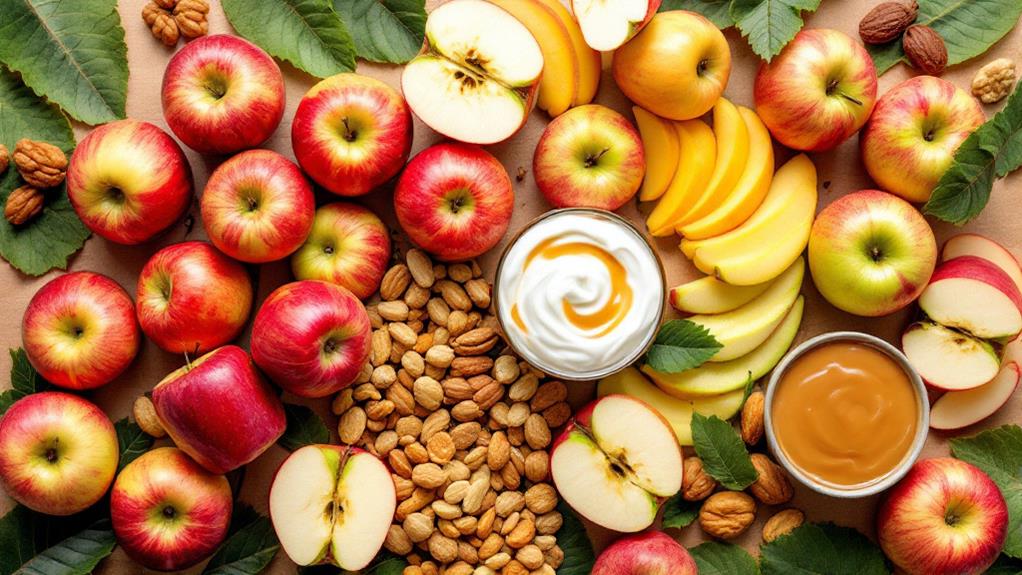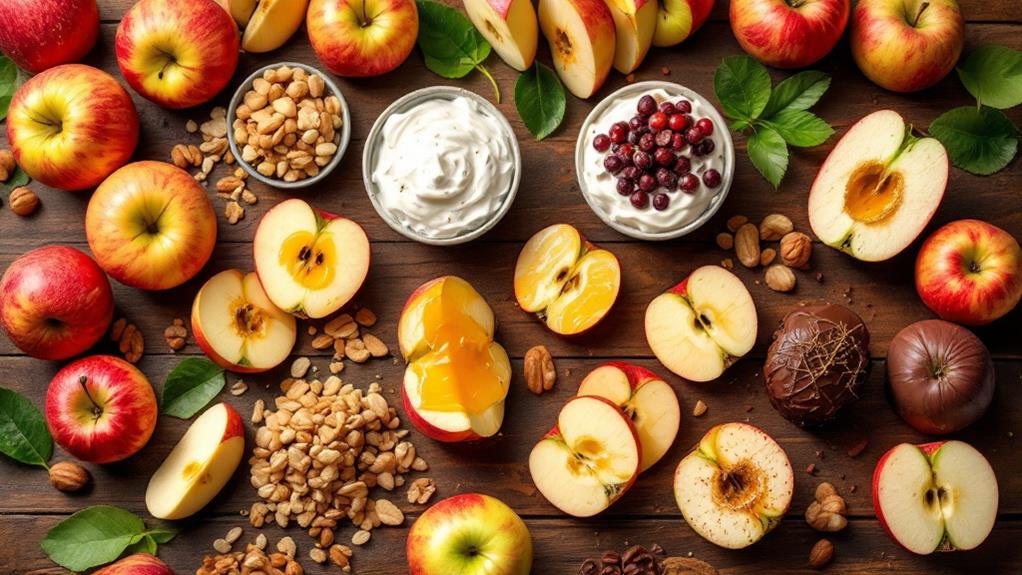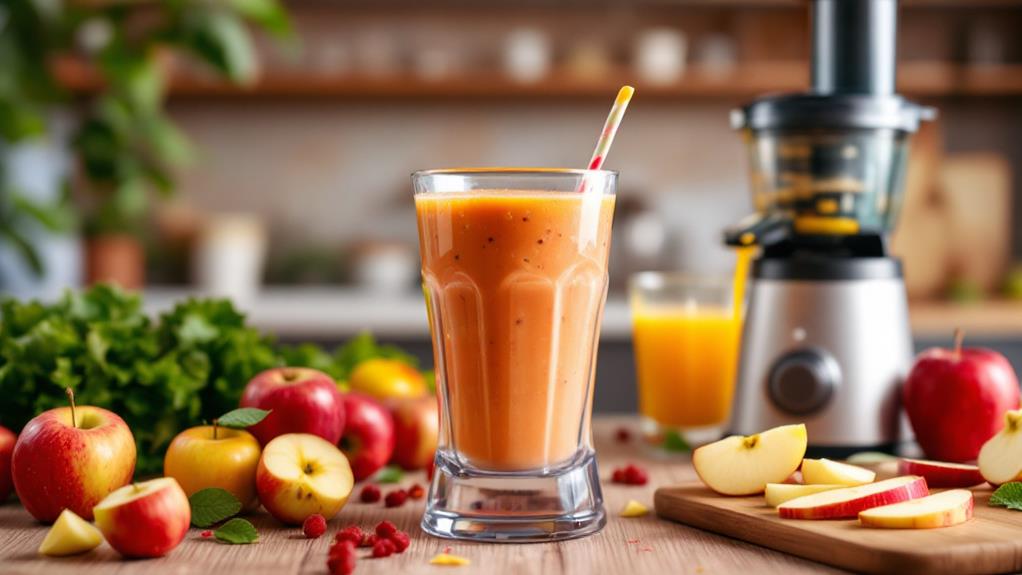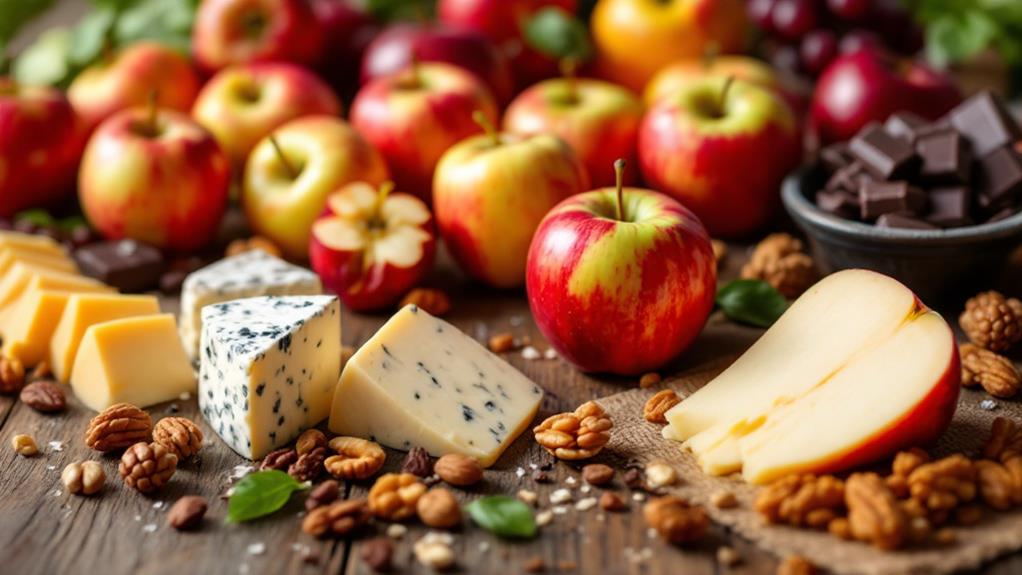The Best and Worst Ways to Eat Apples: Nutrition Tips

Enjoying apples raw, with their skin on, is the best way to harness their full nutritional power, offering fiber and powerful antioxidants. Combine them with protein-rich foods like nut butter for a balanced snack. While Granny Smith apples are great for low-sugar options, Fuji's sweetness shines in baking, although the cooking process can reduce nutritional value. Juicing removes precious fiber, so opt for smoothies to retain it. Be cautious of overconsumption, possible allergies, and seed ingestion. Proper storage improves their freshness and flavor. Uncover ways apples contribute to heart health and disease prevention by exploring more insights ahead.
Understanding Apple Varieties
When exploring the world of apples, it is vital to understand the variety of options available. With over 7,500 apple varieties globally, each brings unique flavors and uses to your table. For instance, Granny Smith apples are known for their tartness and lower sugar content, making them perfect for baking. Fuji apples, on the other hand, are among the sweetest, offering about 13.3 grams of sugar per 100 grams, making them delicious apples for a sweet snack.
Red Delicious apples stand out with their high antioxidant content, providing great health benefits when included in your diet. To truly enhance these benefits, consider consuming whole apples. The apple skin is packed with important vitamins and antioxidants that can elevate your health. From a nutrition perspective, it's wise to accept the variety offered by these apples.
When selecting apples, think about what you're in the mood for—whether it's the tartness of Granny Smith apples or the sweetness of Fuji apples. These nutrition tips will guide you in making the right choice, ensuring that each bite is both flavorful and beneficial to your health.
Nutritional Benefits of Apples
After exploring the diverse world of apple varieties, let's immerse ourselves in the significant nutritional benefits these fruits offer. Apples are a powerhouse of health, packing a punch with every bite. They're high in dietary fiber, giving you about 4 grams per medium-sized fruit. This fiber aids digestion and keeps you feeling full, making apples a fantastic ally for weight loss. With just 95 calories per apple, they're a guilt-free snack that satisfies without adding unwanted pounds.
Apples also shine regarding vitamin C, providing around 14% of your daily intake. This vitamin is essential for enhancing your immune system and maintaining healthy skin. The antioxidants in apples, especially quercetin, combat inflammation and may lower the risk of chronic diseases like heart disease and cancer.
To get the most out of apples, don't peel them. The apple peel is where many vitamins and antioxidants are concentrated, maximizing their health benefits. So, munch on a whole apple to support heart health, strengthen your immune system, and enjoy a delicious, nutrient-rich treat that benefits your comprehensive well-being. Keep them in your daily diet for a crunchy, healthy enhancement!
Eating Apples for Health

Bite into the crisp goodness of apples to access a bounty of health benefits. Eating apples in their raw form is a delicious way to elevate your health. When you eat a whole fruit, you're maximizing your intake of fiber and antioxidants, especially if you keep the skin on. These nutrients are vital for digestive health and can help in disease prevention. A raw apple is not only low in calories but also helps regulate blood sugar levels due to its fiber content, making it an excellent snack choice for weight management.
Granny Smith apples are particularly beneficial if you're looking for options lower in sugar and higher in fiber. These attributes make them a top pick for health-conscious individuals. Pairing apples with protein sources like nut butter or cheese isn't just tasty—it increases satiety and helps stabilize blood sugar levels, offering a balanced and nutritious snack.
Cooking and Baking Apples
Cooking and baking with apples open up a world of culinary possibilities. When you choose cooking apples like Granny Smith or Fuji, you're selecting varieties renowned for their firm texture and ability to hold shape. These qualities make them perfect for baking apples into pies, crumbles, or tarts. They maintain structure while their natural sugars concentrate, offering a sweeter taste. However, this cooking process might slightly reduce their vitamin C and antioxidant levels compared to when they're raw.
For a delightful applesauce, try mixing sweet and tart apple varieties. This combination creates a balanced flavor that improves your dish. Typically, three apples yield around one cup of sauce, making it a handy guide for your recipes. Stewing apples with spices like cinnamon can amplify their flavor and keep most of their fiber content intact. This makes them a nutritious supplement to breakfasts or desserts.
Baking apples in treats like pies or crumbles retains about 80% of their fiber, ensuring they're a satisfying and healthier dessert option. Unlike many processed sweets, these fibrous desserts provide a wholesome treat you can feel good about enjoying.
Juicing and Smoothies

With regard to juicing and smoothies, many people find that using apples can add a natural sweetness and a revitalizing flavor. However, when you juice apples, you lose the fiber that's crucial for digestion and keeping you full. This process results in a drink that's higher in sugar, with about 19g per medium apple, which can spike your blood sugar and increase your caloric intake if you're not careful.
On the other hand, smoothies offer a more balanced approach to enjoying apples. By blending whole apples, you retain the fruit's fiber—around 4g per medium apple—which helps regulate blood sugar levels and keeps you feeling satisfied longer. Plus, when you include the apple skin in your smoothies, you enhance the nutritional benefits, gaining access to antioxidants and phytochemicals that support general health.
Blending apples with other ingredients in smoothies can also improve nutrient absorption, giving you a more rounded intake of vitamins and minerals. So, if you're looking for a nutritious way to enjoy apples, smoothies are a fantastic choice, allowing you to reap the full benefits of whole apples while keeping your blood sugar and caloric intake in check.
Potential Risks of Apples
While smoothies offer a balanced way to enjoy apples, it's also essential to be aware of some potential risks associated with consuming them. Eating too many apples can lead to digestive issues like bloating and diarrhea due to their high fiber content. Moderation is key to keeping your digestive system happy. Furthermore, apple seeds contain amygdalin, which can release cyanide when metabolized—however, you'd need to consume a large quantity of seeds for it to pose a real threat.
Another consideration is high pesticide residues that might be present on apples. To minimize exposure to these harmful chemicals, make sure you thoroughly wash your apples before eating them. If you're someone who suffers from oral allergy syndrome, apples could trigger allergic reactions. This condition can cause itching or swelling in your mouth and throat due to proteins in the fruit.
Moreover, while sliced apples oxidize and turn brown, affecting their appearance and taste, they don't pose a safety risk. Finally, keep in mind that apples can sometimes contribute to oxidative stress if not consumed as part of a balanced diet. Always aim for variety in your fruit intake to avoid this issue.
Buying and Storing Apples

Choosing and storing apples correctly guarantees you enjoy their crispness and flavor for longer. When buying apples, focus on selecting those that are firm and heavy, as these are indicators of freshness and quality. Avoid apples with bruises or soft spots, as these can lead to quicker spoilage. Once you've made your selection, proper storage becomes vital to maintaining their delightful texture and taste.
Refrigerate apples at temperatures between 30-35°F. This greatly extends their shelf life and helps preserve their crispness. To further improve their freshness, wrap each apple in paper. This simple step helps reduce moisture loss, which is fundamental to keeping the apples' texture and flavor intact. Moreover, store apples away from strong-smelling foods. Apples easily absorb odors, which can alter their natural taste.
Regularly check your apples for signs of spoilage. Promptly remove any apples that show decay to prevent them from affecting the others. By following these tips, you'll guarantee that your apples remain fresh and delicious, ready to be enjoyed whenever you're in the mood for a crisp, juicy snack.
Apples in Disease Prevention
Beyond mere enjoyment, regularly eating apples can play a crucial role in disease prevention. With their rich nutrition profile, apples are an excellent ally in maintaining your health. The fiber in apples helps regulate blood sugar levels, which can considerably lower your risk of developing type 2 diabetes and improve insulin sensitivity. This fiber also supports digestive health, potentially reducing the incidence of colorectal cancer.
Antioxidants in apples, particularly quercetin, are powerful in neutralizing free radicals, lowering inflammation, and reducing the risk of certain cancers. These antioxidants, combined with vitamin C, enhance your immune function, helping your body fend off illnesses more effectively.
Heart health is another area where apples shine. The polyphenols in apples can lower cholesterol levels, contributing to a decreased risk of cardiovascular disease. By incorporating apples into your diet, you're not just enjoying a tasty snack; you're actively working on disease prevention and promoting general health.
Incorporating apples into your diet is a simple and effective way to capitalize on their health benefits. By doing so, you're not only savoring their delicious taste but also investing in a healthier future.
Pairing Apples With Foods

Pairing apples with different foods can greatly enhance both their taste and nutritional value. By combining apples with a variety of ingredients, you can create balanced and satisfying meals or snacks. Here are some tasty and nutritious ways to improve your apple experience:
- Nut Butter: Pairing apples with nut butter not only elevates flavor but also adds healthy fats and protein. This combo is a perfect snack for regulating blood sugar levels and keeping you full longer.
- Sharp Cheddar: For a savory twist, try apples with sharp cheddar. The contrast of flavors is delicious, and the added protein and calcium from the cheese promote satiety. It's a great choice when you need a quick, satisfying bite.
- Salads and Leafy Greens: Tossing apples into salads, especially with leafy greens and nuts, increases the meal's fiber and vitamin content. The apples provide a satisfying crunch and boost the general taste.
Cooking apples with oats in a breakfast dish offers a fiber-rich option that supports digestive health. Adding cinnamon or other spices can enhance their antioxidant properties, delivering supplementary health benefits. These pairings make apples both a versatile and nutritious choice in your diet.




